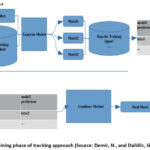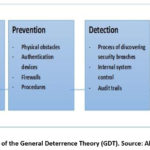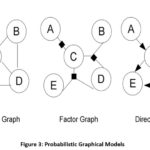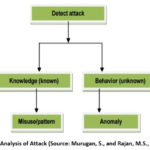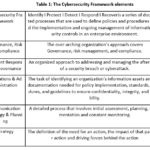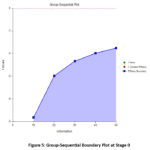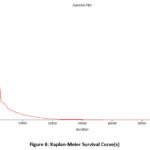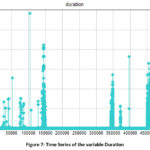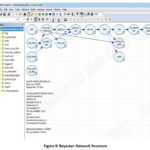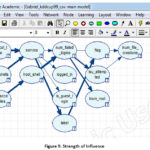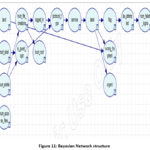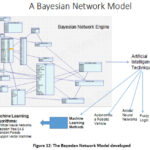Introduction
Background
The monotonic increase
in the use of the internet has precipitated the advent of Network Intrusion
Detection Systems (NIDS). The NIDS draw a distinction between the legitimate
network users from malicious ones, and monitor system usage to identify behaviour
breaking the security policy (Bringas, P.B., and Santos, I., 2010, p.229).
Bayesian Networks (BNs) are directed acyclic graphs that have an associated
probability distribution function and these graphical probabilistic models are
used for multivariate analysis (Bringas, P.B., and Santos, I., 2010, p.231).
P (x) = n∏i=1
p(xi | Ψi)
There are many
intrusion identification methods and these include a semi-supervised fuzzy
clustering algorithm based on isomeric distance and sample density for network intrusion
detection (Kylili et al., 2018), but this method is constrained by the data
sample dimension, and it is difficult to effectively deal with the problem of
large scale network intrusion signal recognition. Based on deep research of
hidden Markov model intrusion detection method, combined with the
characteristics of global optimization of genetic algorithm, Wu (2018) used the
genetic algorithm to optimize the model for the sensitive problem of hidden
Markov model to initial parameters, and proposed an identification method based
on hidden Markov model for ship communication network intrusion signal.
Statement of the problem
The phenomenal growth in the use of
internet-based technologies has resulted in various organizations being
subjected to cyberattacks. The classical security measures, such as a firewall, have proved to be inadequate,
as hackers deliberately avoid firewall protection. It is, therefore, of primordial importance to find
effective solutions that can dynamically and adaptively defend the network
systems. What is required is a network intrusion detection and prevention system based on the
Bayesian Network structure for use in Cybersecurity.
Purpose of Study
The purpose of this research is to develop
a structure for a network intrusion detection and prevention system based on
the Bayesian Network for use in Cybersecurity. There is need to find effective
solutions that can dynamically and adaptively defend the network systems, and
so Bayesian networks allow for prediction, generalization, and planning.
Research Objectives
The objectives of this research were to:
- Determine the cybersecurity framework appropriate for a developing
nation like Zimbabwe.
- Evaluate network detection and prevention systems that use
Artificial Intelligence paradigms.
- Analyse Bayesian Networks that
can be represented as graphical models and are directional to represent cause-effect
relationships
- Develop a Bayesian Network model that can handle complexity in
cybersecurity.
Research Questions
The main research
question is:
What Bayesian
Network model is most appropriate for a network detection and prevention
cybersecurity system?
The sub research
questions were:
- What is
the most appropriate cybersecurity framework for a developing nation?
- How are
Artificial Intelligence paradigms used in network detection and prevention
systems?
- How can
Bayesian Networks be represented as graphical models that also represent
cause-effect relationships?
- How do you
develop a Bayesian Network model that can handle complexity in cybersecurity?
Review of the Literature
Conceptual
Framework
According to Wu (2018,
p.2), there are two main advantages to the preprocessing of the network signal
by the principal component analysis (PCA) method:
- PCA can reduce the dimension of the network
signal collected on the receiving device, that is, extract the fluctuation
signal related to the network activity, reduce the amount of calculation and
improve the recognition accuracy.
- As the background noise of the network
environment is random and irregular, PCA can use the relative change rate to
eliminate the noise in the background environment.
Wu (2018) proposed a
hidden Markov model-based intrusion signal recognition method for ship
communication network for the problem of low recognition accuracy and initial
parameter sensitivity in the current network intrusion recognition method,
where the principal component analysis method was used to denoise and classify
the network continuous signals by selecting appropriate k value. In the process
of building and training hidden Markov model, an improved genetic algorithm was
used to optimize the initial parameters of the hidden Markov model. Karimpour et al (2016, p.2) categorized the intrusion detection approaches into four parts as
follows:
1) Feature-based approaches
2) Decomposition-based approaches
3) Community-based approaches
4) Window-based approaches
The training phase of the tracking approach is shown on Figure 1 below.
The conceptual
framework of the research is premised on the National Institute of Standards
and Technology (NIST) framework. The NIST Cybersecurity Framework seeks to
provide organizations with a common way to:
- describe their current (as-is) cybersecurity
state or posture
- describe their desired cybersecurity state
- identify and prioritize opportunities for
improvement within the context of a continuous and repeatable process
- make progress assessment towards a desired
cybersecurity state
- make internal or external communication to
stakeholders about cybersecurity risk
The cybersecurity
challenges that are being faced in developing countries include the following:
1. Infrastructure (International
Telecommunications Union, 2009)
2. Legal frameworks
(Norwegian Institute of International Affairs, 2018)
3. Harmonization of
legislation(Bande, 2018).
4. Balancing
harmonization and country specific needs (ITU, 2012)
5. Systems (Schia,
2018)
6. Education and
awareness (Tagert, 2010), (Schia, 2018)
7. Cybersecurity
knowledge (The United Nations Economic Commission for Africa Policy Brief,
2014)
8. Affordability and
funding (Muller, P. L, 2015)
9. Perceived low
susceptibility to attacks (Tagert, 2010)
10. Lack of adequate
frameworks that speak to their cybersecurity needs (Tagert, 2010)
11. Reporting
cybercrime (The Republic of Mauritius Cybercrime strategy 2017-2019, 2017)
12. Data sharing
The research work is
further founded on the General deterrence theory (GDT), illustrated by the
elements shown on the diagram shown on Figure 2 below.
The Game Theory
approach describes the interaction process among the attacker and the
protecting agent in order to balance and strategize the prediction of the
behaviour of the attacker in the search to find an equilibrium point for
optimal results. Game theory amply illustrates multi-person decision scenarios
as games where each player gets the best possible rewards for self by making
appropriate choices of actions, while expecting the logical actions from the
other opponents. According to Chukwudi et al (2017), a game is a narrative or
an account of the strategic reciprocal actions between opponents including
payoffs of and constraints for actions that players can undertake but doesn’t
specify the exact actions taken. A player is the primary entity of a game
responsible for making decisions and then taking action and can represent a
machine, a person, or a group of persons within a game (Chukwudi et al, 2017).
In the field of cybersecurity, game theory will take into account the wrangle
between the cyber attackers and the cyber victims where their decision
strategies are closely related. An important element in this theory is the
capacity to analyze the possible large number of cyber threat scenarios in a
cyber system (Hamilton, 2002).
Chaos theory is a
specialised application of dynamical systems theory with a focus on the
qualitative study of unstable, aperiodic behaviour in deterministic,
non-linear, dynamical systems (Kabanda, G., 2013). In seeking to understand the
behaviour of a complex system, Chaos theory reconstructs its attractor to
obtain qualitative understanding. Chaos theory asserts relationships of
qualitative (or topological) similarity between the abstract models and the
actual systems under study. Its great value is in varying and analyzing models
of natural systems for the purposes of adaptability and comparison (Kabanda,
G., 2013). Chaos is a sub-discipline of complexity. There are three aspects of
Chaos that relate to fractal patterns, bounded infinity, and unpredictability
(Smitherman, S., 2014, p.6).
Data mining or knowledge
discovery in databases (KDD), is the automated process of extraction of
patterns of knowledge implicitly stored in large databases, data warehouses,
and other massive information repositories. According to Madigan, D. (2008,
p.3), data mining is purposed to find interesting patterns, predictive models,
and hidden relationship in data. In this way, the extraction of interesting
(non-trivial, implicit, previously unknown and potentially useful) patterns or
knowledge from huge amount of data (interesting patterns) is realised. Some of
the common tasks in data mining include predictive modeling, segmentation,
summarization and visualisation. Neural network methods have had a great impact
on pattern recognition by proving a taxonomy of models with large but not
unlimited flexibility of a large number of parameters. Multi-layer perceptrons
and radial basis functions (RBFs) are the two most widely used neural network
architectures.
Cryptography protects
information by encrypting it into an unreadable format, called cipher text. The
message can only be deciphered into plain text by the recepient who possess a
secret key. Cryptographic algorithms can be classified in various ways,
depending on the number of keys that are employed for encryption and decryption
(Kessler, 2019, https://www.garykessler.net/library/crypto.html ). The
importance of cryptography in computer technology is centered on three areas,
which are Authentication, Integrity and Confidentiality. Applications of
Cryptography include the following:
- Cryptography is applied in many areas of
computer technology, especially wherever information needs to be kept
confidential.
- Modern cryptography is used by governments,
military, financial institutions, medical institutions, space agencies, portable
smart devices, social media platforms and several other sectors of business and
society. The latest common use of cryptography is the creation of virtual
money, called crypto-currency. Crypto-currency is not governed by the normal
banking systems of the world. It is traded by anyone, unfortunately that also
includes money launderers, terrorist financiers because normal systems cannot
trace the funds’ movements. The levels of encryption are very high to keep this
money secure on the various platforms. The types of crypto-currency that exist
so far are Bitcoin, EOS, Cardano (ADA), NEO, Monero (XMR), DASH, Zcash (ZEC),
Ripple (XRP), Ether and Litecoin (LTC).
- Other
applications for cryptography are protecting stored files, full disk encryption
which is additional protection to the operating system and not just the stored
files, device locking encryption that is built to activate each time the device
is locked, virtual private networks (VPN) as a way of creating an encrypted
connection between a remote user and a site, secure web browsing used when
users visit sites that facilitate financial transactions or communication that
must be confidential, secure messaging, and protecting Confidentiality in Cloud
or Third-Party Computing.
In Machine Learning
(ML), the primary focus is the development of computer programs that can
access data and use it learn to for themselves
(https://www.expertsystem.com/machine-learning-definition/ ). Large amounts of
data are required in ML for the analysis by computers to learn. It takes time
resources to achieve effective machine learning. Organisations or individual
users aim to improve how they work and experience life. Having computer systems
that can take over some tasks that cannot be programmed in faster and more
accurate ways than a human being, helps to achieve these desired improvements.
The benefits of using AI and machine learning in cybersecurity include
automated protection, faster response and protection, personalization, learning
to adapt to the situation unobtrusively, usability. Applications of Machine
Learning include the following:
- Virtual Personal Assistants, e.g. Siri, Alexa,
Google, etc.
- Predictions while Commuting, as in Traffic
Predictions and Online Transportation Networks which assist commuters to travel
faster in the most cost effective way possible.
- Videos Surveillance where AI learns to
understand and predict human behaviour through body movement.
- Social Media Services which help users to
connect online with People they may know by learning profiles on platforms such
as Facebook.
- Email Spam and Malware Filtering which filter
possible spam through learning a user’s email patterns and common recipients.
- Customer Support Services that respond to basic
customer queries.
- Search Engine Result Refining.
- Product Recommendations for the users browsing
patterns on shopping websites to predict and recommend the desired products.
- Online Fraud Detection to determine genuine and
potentially fraudulent online transactions.
Modern Literature
(2018-2019)
Bayesian Networks can
be considered as causal models and learned from observational data, which has
wide applicability in different areas of life (Jabbari, F., et al, 2018,
p.169). Jabbari, F., et al (2018, p.169) viewed a given person as a joint set
of causal mechanisms, where each mechanism is typically shared with many other
people, but the joint set is essentially unique to that person. For that given
person, the causal learning task is to construct the correct set of mechanisms
for that person from the features we know about the person and from a training
set of data on many other people. This instance-specific causal learning
approach is applicable to other causal systems, even beyond human biology. A
Bayesian Network (BN) as a graphical model represents probabilistic
relationships among a set of variables (Jabbari, F., et al, 2018, p.171). It
follows that the Greedy Equivalence Search (GES) is a state-of-the-art method
for learning a BN structure from observational data. According to Jabbari, F.,
et al (2018, p.171), GES algorithm consists of a forward equivalence search
(FES) and backward equivalence search (BES). Each forward and backward step in
GES involves scoring a single node given its parents; therefore, it requires a
node-wise decomposable score. The development of a Bayesian approach for
learning a BN structure amounts to search for a structure with a high posterior
probability on a given dataset.
The instance-specific
Greedy Equivalence Search (IGES) method by Jabbari, F., et al, (2018, p.179)
had limitations but can be improved and extended through the following ways:
- understand better the reason for the relatively
lower recall of the instance-specific BN models and try to increase it while
retaining precision;
- extend the IGES algorithm to iteratively learn
an instance-specific model for each instance in the training set and use an
aggregate of those models to define the population-wide model;
- attempt to
prove that IGES is guaranteed to find the data-generating instance-specific
causal model for a test instance in the large sample limit;
- develop an instance specific score to learn BN
structures that contain other types of variables (e.g., continuous or a mixture
of continuous and discrete variables);
- develop more informative structure and
parameter prior probabilities;
- extend the
experimental evaluations.
However, the work by
Jabbari, F., et al, (2018) provides support that the proposed IGES method is a
promising approach to discover a BN structure that better models the
relationships among variables of a given instance T, rather than a population
wide model. Figure 3 below shows the Probabilistic graphical models.
The open society of
the internet presents unpredented risks of cyber-attacks on computer systems
and data. The process of intrusion detection often includes data collection,
data pre-processing, intrusion recognition, and reporting and response (Xiao,
L., 2016, p.1). Effective and efficient intrusion detection systems are needed
to promptly detect and prevent intrusion to fight against extraordinarily
intelligent cyber-attacks. Xiao (2016, p.1) categorised the intrusion detection
systems into signature-based intrusion detection, anomaly based intrusion
detection, and hybrid intrusion detection.
According to Liao et
al cited in Xiao, L. (2016, p.10), there are three
main challenges in current intrusion
detection researches:
- Lower the false negative rate is one focus for signature-
based intrusion detections, especially for some zero-day attacks. Furthermore,
lower the false positive rate is a focus for anomaly-based intrusion detection.
- Collect training data set to build intrusion detection system. An intrusion may cause
changes in some network traffic
features. A problem of great interest
in the training of intrusion detection systems is how to select key and effective
features from a huge set of possible related features.
- Enable intrusion detection systems to respond promptly and be real time.
Methodology
Presentation of the
methodology
Research Philosophy
According to Lather
(1986) as cited by Kivunja and Kuyini (2017) a research paradigm gives a
reflection of the researcher’s opinions. According to Lincoln and Guba (1985)
as cited by Kivunja and Kuyini (2017) a paradigm has four parts which are
explained below.
Epistemology of a
paradigm
The word epistemology
is a Greek word which means knowledge (Kivunja and Kuyini , 2017) and is
concerned with the theory of knowledge (Walliman, N., 2011).
Ontology of a
paradigm
According to Scotland
(2012) as cited by Kivunja and Kuyini (2017), ontology is a division of
philosophy that deals with the assumptions made in believing that something is
real or makes sense.
Methodology of a
paradigm
According to Keeves
(1997) as cited by Kivunja and Kuyini (2017), methodology is an umbrella term
used to cover research methods, research design and procedures used in a
planned investigation to find out something.
Axiology of a
paradigm
Axiology handles the
ethical issues taken into consideration when conducting research (Kivunja and
Kuyini, 2017). Ethical considerations focus on four key concepts that have to
be respected when dealing with data and participants. According to Slote (1985)
cited in Kivunja and Kuyini (2017), these are Privacy, Accuracy, Property and
Accessibility and the acronym that denotes them is PAPA.
Positivist paradigm
Kivunja and Kuyini
(2017) state that the positivists believe that truth is out there and can be
revealed through research and the role of the researcher is to find it and
explain it. They also believe that theory is universal and can be applied in
all settings or contexts. The positivist paradigm defines a worldview called
the scientific method (Shah, S.R., and Al-Bargi, A., 2013) of investigation
which is anchored on an experimental methodology.
Interpretivist/Constructivist paradigm
Lincoln and Guba
(1985) and Morgan (2007) cited in Kivunja and Kuyini (2017), presented this
paradigm as one where in the world numerous realities are in existence and
reality is too complex to control every variable. In this regard context is
extremely important for knowledge and understanding.
Critical
/Transformative paradigm
This paradigm follows
a worldview that centres its research in issues of social injustice (Shah S.R.,
and Al-Bargi, A., 2013) and aims at addressing political, economic and social
issues which lead to oppression, conflict and struggle. It strives to change
politics in order to address inequality and injustice hence the name
transformative (Kivunja and Kuyini, 2017). According to Guba and Lincoln (1988)
and Martens (2015) cited in (Kivunja and Kuyini, 2017).
Pragmatic paradigm
Philosophers inclined
to the pragmatic paradigm subscribe to the worldview that says it is impossible
to access the truth of the real world by employing a single scientific method
as supported by the Positivist paradigm or construct social reality under
Interpretivist paradigm. According to Cresswell (2003) and Martens (2015) cited
in Kivunja and Kuyini (2017) this world view puts it clearly that research must
be feasible and the researcher should use what works given the research problem
without worrying about whether the questions are exclusively quantitative or
qualitative. The best approaches to the acquisition of knowledge and every
methodology that helps knowledge discovery should be used as guided by the
purpose of the study. In this research, an Interpretivist or Constructivist
paradigm was used.
Interpretivist
paradigm/Constructivist paradigm
According to Guba and
Lincoln (1989) as cited by Kivunja, C., and Kuyini, A.B. (2017, p.26), this
paradigm is purposed to understand the viewpoint of the subject under study so
as to interpret what the subject is thinking or the meaning that s/he is making
of the situation or setting. It is based on the idea that reality is socially
constructed and there is no single reality or truth hence the name
constructivist paradigm. There is also need to understand the individuals than
just to follow laws that are generic and for that reason theory does not come
before research but follows it based on data generated from the research.
The Pragmatism
Paradigm
The Pragmatism
paradigm used in this research, as a philosophy is intricately related to the
Mixed Method Research (MMR). The paradigm comprises four elements, namely,
epistemology, ontology, methodology and axiology. The Pragmatic paradigm
advocates a relational epistemology, a non-singular reality ontology, a mixed
methods methodology, and a value-laden axiology which benefits people (Kivunja,
C., and Kuyini, A.B., 2017, p.26). Pragmatism acknowledges the full dialectics
between knowledge and action, where proper action is knowledgeable action and
proper knowledge is actable knowledge. Pragmatism is a philosophy of knowledge
construction that emphasizes practical solutions to applied research questions
and the consequences of inquiry (Peter, G.R., et al, 2005, p.9). Peter, G.R.
(2005, p.9) put it simply that pragmatists opt for methods and theories that
are more useful to use within specific contexts (e.g., answers to practical problems),
not those that reveal underlying truths about the nature of reality.
Research
methodology
A research methodology
can be viewed as a procedural or step by step outline or framework within which
research is done, according to Remenyi et al (1998) as cited by Mohajan (2018).
Research methodology can be quantitative, qualitative or mixed. In this
research, a mixed method approach was taken. The research method of mixed
methods is largely quantitative with the research design being a survey and an
experiment, but supported by qualitative approaches where Focus Group
discussions are held. According to Cresswell, J.W. (2014), in a mixed methods
methodology the researcher mixes both qualitative and quantitative data and
employs the practices of both qualitative and quantitative research. It is also
underpinned by the pragmatic paradigm. Research methodology can be
quantitative, qualitative or mixed.
Research design or methods
The choice of the
qualitative research methodology in this research is guided by the underlying
Interpretivist paradigm that seeks to understand the thought process of
respondents in a certain context and generate new concepts or theories.
Statistical intrusion detection involves creation and analysis of user profiles
based on each user’s observed behavior, hence the form of supervised
classification.
Data
collection/generation through Focus groups
A focus group is a
qualitative data collection method in which a researcher or researchers and
respondents assemble to discuss a certain research topic (Freitas et al, 1998).
According to Hancock et al (2007), focus groups look a lot like interviews but
focus group records can be analysed so as to discover the ways in which the
participants interact with each other and influence each other’s voiced ideas
which does not happen in a one on one interview. Topic guides are normally used
so as to avoid loss of focus on the topic under study. According to Kitzinger
(1995) as cited by Dilshad and Latif (2013), focus groups are mostly favourable
when a researcher wants to find out the people‘s understanding and experiences
about the problem and reasons behind their particular pattern of thinking.
Focus groups give a chance to the marginalized groups of the society to divulge
their feelings about their needs and problems. In this research, focus groups
were used and the researcher led the discussion and respondents responded to
open ended questions. A sample size is the number of respondents from which the
researcher gets the required information (Kumar, 2011). The sample size is 8. A
total of 8 participants attended a Cybersecurity Workshop facilitated by the
researcher at the Harare International Conference Centre (HICC), on Thursday
7th and Friday 8th March, 2019. This is the Focus Group that was used at this
stage of the research project.
Quantitative Data
Collection of KDD’99 Dataset
The research uses the
KDDCup 1999 intrusion detection benchmark dataset in order to build an
efficient network intrusion detection system. The primary data, with about 10
million records and 42 attributes, was obtained from
http://kdd.ics.uci.edu/databases/kddcup99/kddcup99.html. However, a sample of
494,020 instances were selected for data analsys.
Population and
Sampling Technique
The research
established the population, the sample frame, determined the sample design and
the sample size and sampling technique as detailed in the sections below. A
sample size is the number of respondents from which the researcher gets the
required information (Kumar, R., 2011). Saunders et al (2009) defines a
population as the full set of cases from which a sample is taken. Population
also refers to the whole group of things of importance that the researcher
wishes to study (Saunders et al,2009). The sample is 2 million network
intrusion detection and prevention records. For this study the unit of analysis
was the KDD’99 Dataset where 494,020 instances for network intrusion detection
records were analysed. The sampling frame is defined by Saunders et al (2009)
as a comprehensive list of members of the population from which a sample is
drawn. Since the population size is finite and known the Researcher will use the
Yamane’s formula to arrive at a sample size (Saunders et al, 2009). A 95%
confidence level (0.05) was used to calculate the sample size for the study.
The study utilized the purposive sampling method.
Data Analysis
Methods
The primary data collected
from KDD’99 Dataset. From a population of 10 million network traffic data, a
sample of 494,020 records of primary data with 42 variables was analysed using
mainly the SNORT open source software and other Bayesian Network supportive
platforms such as NCSS 2019, Pass 2019, GeNIe 2.3, WinBUGS14, BayES and
Analytica 5.1. From the data collected, we need to find patterns, connections,
relationships, and meaningful insights from the data. Both quantitative and
qualitative data was analysed.
The primary data
collected consist of 42 attributes. The required key variables are the
following types of attacks:
1.DoS – Denial of
Services
2.Scan.
3.Local access
4.User to root
5.Data
Detailed AnalysiS
Bayesian networks
allow for prediction, generalization, and planning. The analysis of attack can
be structured according to the schema shown on Figure 4 below.
The SNORT open source
software and other Bayesian Network supportive platforms such as NCSS 2019,
Pass 2019, GeNIe 2.3, WinBUGS14, BayES and Analytica 5.1, were used to analyse
the quantitative data.
Problems with
Cybersecurity in Zimbabwe
The Focus Group gave
the following as the problems with Cybersecurity in Zimbabwe:
- There is a problem on the clarity on responsibilities or wwnership of who deals with what with regards to Cybersecurity. Some regard it as an ICT problem or technical problem and yet it is more social than technical.
- The Ubiquitous nature of technology and advances in the Internet of Things (IoT) presents serious challenges, where many smaller devices are now accessing the internet and yet present a high risk on cybersecurity. Telecommuting has become more common worldwide and so one cannot tell whether the device scanning your organisation is from home, down the street or from any part of the world.
- Security is being regarded as an after thought, i.e. Cybersecurity strategy is not part of the Business Strategy of the organizations.
- Over dependence on one service provider is not safe, e.g. Ecocash. In the unlikely event of a breakdown, the whole nation cannot do financial transactions. A national payment system is required and should be provided by the Government or national system to guarantee assurance of services for services of national signficance.
- The African culture in Zimbabwe is still weak and has had very little exposure on the cyber space, and has not matured on the use of plastic money. Cyber criminals often take advantage of such a situation.
- We must demand redundance from the service providers and so Service Level Agreements (SLAs) must be enforced and followed through.
- Affordability and availability of electricity to only 3% of the population and internet access to only 47% of the population in Zimbabwe gives room to manipulation by all kinds of criminals.
- There is need for technical measures and clear Cybersecurity Visions that are implementable in our environment.
- The awareness training programmes need to be conducted more frequently even up to the grassroots level to raise awareness in Zimbabwe.
- There is need for a national skills audit on Cybersecurity so that we swiftly address the skills gaps and delinquency in the competence levels. Furthermore, the few Zimbabweans well exposed to Cybersecurity are suffering from Brain Drain as they are targeted for employment in other countries.
- The national ICT Policies and Cybersecurity policies are not simplified enough for ordinary citizens and people at grassroots levels to understand and implement.
- Our own education system is too weak on Cybersecurity skills. There is need to introduce mandatory Cybersecurity courses at certificate, diploma and degree levels. For non-graduates, the courses can be introduced somehow.
- The awareness on cybersecurity laws and legal frameworks is almost zero, and so the nation needs to be equipped to handle cybercrime.
The project identified
the cybersecurity framework elements shown on Table 1.
An evaluation of the
different Artificial Intelligence (AI) techniques that can be used in support
of Intrusion (Anomaly and Misuse) Detection Systems was conducted in order to
provide better Intrusion Detection and Prevention. The research shed some light
on techniques such as Machine Learning (ML), Neural Network and Fuzzy Logic,
and how these can be coupled with NIDS to detect attacks on private networks. Since
most of the Intrusion Detection System are signature based, to develop such a
sophisticated Intrusion Detection System that can detect and prevent already
known and predict unknown attacks is technically unfeasible. An Intrusion Detection
System (IDS) can either be bifurcated as a Network IDS) (NIDS) or as a Host
IDS) (HIDS).
The results of the
T-Tests for the two means for the Network Intrusion Detection and Prevention
System is summarised below and shown on Figure 5 and Figure 6. Time series of
the Duration variable is shown on Figure 7.
From the primary data
of 494,020 records, there are 42 variables that were analysed where the
protocol_type has value tcp and service of value http.
The Bayesian Network
structure derived is shown on Figure 8 below:
The consequent
strength of influence is shown on Figure 9.
The bar chart of the
node properties are shown on Figure 10.
Overall Outcomes
The cybersecurity
challenges that are being faced in developing countries, like Zimbabwe, include
the following:
- Infrastructure (International
Telecommunications Union, 2009)
- Legal frameworks (Norwegian Institute of
International Affairs, 2018)
- Harmonization of legislation(Bande, 2018).
- Balancing harmonization and country specific
needs (ITU, 2012)
- Systems (Schia, 2018)
- Education and awareness (Tagert, 2010), (Schia,
2018)
- Cybersecurity knowledge (The United Nations
Economic Commission for Africa Policy Brief, 2014)
- Affordability and funding (Muller, P. L, 2015)
- Perceived low susceptibility to attacks
(Tagert, 2010)
- Lack of adequate frameworks that speak to their
cybersecurity needs (Tagert, 2010)
- Reporting cybercrime (The Republic of Mauritius
Cybercrime strategy 2017-2019, 2017)
- Data sharing
Organizational
policies should spell out the procedures for handling information security,
with some legal assistance. The policies should cover the following areas
(Nielsen, R., 2015, p.14):
- Personal Electronic Devices (PED)
- Acceptable Use
- Records Retention
- Identity Protection
- Server, Service and Project Computing Security
- Data Encryption
The Cybersecurity
Vision consists of the following five elements:
- Talent centricity
- Strategy and innovation
- Risk focus
- Intelligence and agility
- Resilience and scalability
The research shed some
light on techniques on Machine Learning (ML), Neural Networks and Fuzzy Logic
and how these may be coupled with an intrusion detection and prevention system
to detect attacks on private networks. The benefits of using AI and machine
learning in cybersecurity are as follows:
- Automated protection
- Faster response and protection
- Personalization
- Learn to adapt to the situation unobtrusively
- Usability
The perfected Bayesian
Network structure is shown on Figure 11.
A Bayesian Network is
represented as a directed acyclic graph. Each node of a Bayesian network (BN)
is a label that is an attribute of the problem, and these attributes are binary
which can take the value TRUE or FALSE, which means that a random variable is
associated with each attribute. Several problems are faced in the use of BNs:
- The correspondence between the graphical
structure and associated probabilistic structure for purposes of simplifying
all the problems of inference problems in graph theory;
- The operation for transposition of the causal
graph to a probabilistic representation.
The Naive Bayes is a two-layer Bayesian
network that assumes complete independency between the nodes, and is an
application of BNs in anomaly detection.
Analysis
The cybersecurity
challenges that are being faced in developing countries, like Zimbabwe, include
the following:
1.Infrastructure
2.Legal frameworks
3. Harmonization of
legislation
4. Balancing
harmonization and country specific needs
5. Systems
6. Education and
awareness
7. Cybersecurity
knowledge
8. Affordability and
funding
9. Perceived low
susceptibility to attacks
10. Lack of adequate
frameworks that speak to their cybersecurity needs
11. Reporting
cybercrime
12. Data sharing
The key components of
a Cybersecurity Framework with the supportive strategies, in accordance with
the National Institute of Standards and Technology (2018)
(http://www.nist.gov/cyberframework), requires a clear focus on the need to
identify, protect, detect, respond and recover from potential threats and
attacks. The intrusion detection and prevention system (IDPS) components must
first and foremost be secure since it is the primary target of attackers who
try to prevent the IDPSs functioning of detecting attacks or to access the
sensitive data on IDPSs like host configuration and known vulnerabilities. The
recommended security control measures are:
1. Remove Unnecessary
Services, Applications and Protocols
2. Configure Users,
Groups, and Authentication
3. Configure Resource
Controls
4. Install Additional
Security Controls
5. Test the System
Security
6. Security
Maintenance
7. Logging
8. Data Backup and
Archive
9. Access Control Scheme
The Bayesian Network
Model developed is shown on Figure 12.
A majority of the
currently available network security techniques cannot cope with the dynamic
and increasingly complex nature of the attacks on distributed computer systems.
Therefore, an automated and adaptive defensive tool is a necessary and
sufficient condition of computer networks. Artificial Intelligence (AI)
technologies such as Artificial Neural Networks (ANN) have been adopted to
improve detection performance.
The pros and cons of data mining techniques
are shown on Table 2 below.
 |
Table 2: Advantages and disadvantages of data mining techniques (Source Almutairi, A. (2016) p.43)
Click here to View Table
|
The summary of the
comparative analysis is illustrated on Table 3 below.
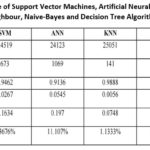 |
Table 3: Performance of Support Vector Machines, Artificial Neural Network, K-Nearest Neighbour, Naive-Bayes and Decision Tree Algorithms
Click here to View Table
|
An intrusion detection
system is known to monitor computer systems and networks in order to determine
if a malicious event (i.e., an intrusion) has occurred, and each time a
malicious event is detected, the IDS raises an alert (Bolzoni, D., 2009, p.13).
The overall user of an IDS is influenced by False positives, rather than false negatives.
It is possible to
build an intrusion detection system for containers running in the cloud
environment, as the presented enriched data representation and framework allows
the development of accurate, efficient, and intelligent intrusion detection
Systems for cloud computing using machine learning algorithms (Aljebreen, M.J.,
2018, p.6). The summary characteristics of an intrusion detection system (IDS
are that (Aljebreen, M.J., 2018, p.11) it:
1. Runs continuously
without human supervision.
2. Is fault tolerant
to able to recover from crashes.
3. Is simply tailored
to a specific network.
4. Adapts to behaviour
changes of user/system over time.
5. Works in real-time.
6. Detects maximum
number of intrusions with minimum number of false?positive alarms.
7. Is self-monitored.
8. Is
self-configurable to the security policies changes.
9. Operates while maintaining
minimum overhead
There are various
numbers of artificial neural networks algorithms. Multilayer perceptrons is one
of the most popular types of neural network that is used in many applications
such as intrusion detection. It was chosen to be used by Aljebreen, M.J. (2018,
p.32) as an effective alternative to more traditional statistical techniques,
as it can be trained to approximate virtually any smooth, measurable function;
it is not concerned with data distribution and makes no prior assumptions about
that; it models highly non-linear functions; and it can be trained to
accurately generalize when presented with unseen data in the testing data.
The data structure of
Decision Tree C4.5 follows the divide-and-conquer strategy, and its a well-known
algorithm that can be used for classification and regression (Aljebreen, M.J.,
2018, p.32). There are many decision tree algorithms, and the most well-known
algorithm to build trees is the C4.5 algorithm which is most appropriate in
developing a classification based intrusion detection system.
The random forests
algorithm adds an additional layer of randomness to bagging. In bagging
(Bootstrap aggregation), multiple trees are fit in to subsampled data where the
prediction is calculated by averaging the majority votes of each tree’s
response. However, in random forests, each node is split differently by using
the best split among a subset of predictors that is picked randomly at that
node; which helps to overcome the overfitting problem. Random forests also have
an ability to handle high dimensional data (Aljebreen, M.J., 2018, p.33).
The principle of the
support vector algorithm (SVM) is to derive a hyperplance, which maximizes the
separating margin between the positive and negative classes (Aljebreen, M.J.,
2018, p.34). The SVM algorithm becomes popular for its generalization ability,
especially for its high number of features, m, with low numbers of data points,
n. However, training the SVM with a dimensional quadratic programming (QP)
problem involves large matrix operations that result in large numbers of
computations which lead to slow performance. Of late, many enhancements have
been applied to the SMO algorithm which increases its performance even more
than before. Hence, the SVM algorithm in general has been used for decades for
both anomaly and misuse detection.
Conclusion
The main research
question was:
What Bayesian
Network model is most appropriate for a network detection and prevention
cybersecurity system?
The purpose of this
research was to develop a structure for a network intrusion detection and
prevention system based on the Bayesian Network for use in Cybersecurity. The
objectives of this research were to:
- Determine the cybersecurity framework
appropriate for a developing nation.
- Evaluate network detection and prevention
systems that use Artificial Intelligence paradigms.
- Analyse
Bayesian Networks that can be represented as graphical models and are
directional to represent cause-effect relationships
- Develop a Bayesian Network model that can
handle complexity in cybersecurity.
The objectives of the
research were achieved. It is of primordial importance to secure the intrusion
detection and prevention system (IDPS). Supportive security control measures
and policies are required. There are numerous cybersecurity challenges that are
being faced in developing countries, like Zimbabwe.
An evaluation of
Artificial Intelligence paradigms for network detection and prevention systems
covered machine learning methods, autonomous robotic vehicle, artificial neural
networks, and fuzzy logic. To develop such a sophisticated Intrusion Detection
System that can detect and prevent already known and predict unknown attacks is
technically unfeasible since most of the Intrusion Detection Systems are
signature based. The current trend is to use Expert Systems, Neural Network,
Genetic Algorithm, Fuzzy Logic and other AI techniques in improving the
capabilities of IDS. Expert Intrusion Detection Systems are being developed for
recognising and learning through patterns. Neural networks are trained for a
specific problem domain provide reasonable solutions with representative sets
of training data, but is not able to handle streaming data, and therefore, it
is necessary for the individual protecting our system, to take off-line the
data whenever he needs to train the model and to run it to the updated set of
representative data. The Generic Vehicle Architecture specification equipped
with a variety of popular communication and sensing technologies can be handy
and makes a promisory note. Due to their dependence on sensing, communication
and artificial intelligence, cyber-physical systems, such as cars, drones and
unmanned vehicles are attractive targets for attacks that cross the cyber-physical
divide, from forcing a car to veer off road, to hijacking a drone or
overwhelming a driverless car’s lidar sensors. Fuzzy Logic is most effective
when solving complex problems, where it consists of a fuzzy set of elements
where the membership of any element in the fuzzy set can vary from 0 to 1.
Fuzzy Rough C-Means will partition the data into 2 classes: lower approximation
and boundary.
The research used the
KDDCup 1999 intrusion detection benchmark dataset in order to build an
efficient network intrusion detection system. From a population of 10 million
network traffic data, a sample of 494,020 instances of primary data with 42
variables was analysed using mainly the SNORT open source software and other
Bayesian Network supportive platforms such as NCSS 2019, Pass 2019, GeNIe 2.3,
WinBUGS14, BayES and Analytica 5.1. A structural equation modelling was done
for the Bayesian Network model.and the Bayesian Network structure developed.
The performance of Support Vector Machines, Artificial Neural Network,
K-Nearest Neighbour, Naive-Bayes and Decision Tree Algorithms was discussed.
Alternative improved solutions discussed include the use of machine learning
algorithms specifically Artificial Neural Networks (ANN), Decision Tree C4.5,
Random Forests and Support Vector Machines (SVM).
Effective and
efficient intrusion detection systems are needed to promptly detect and prevent
intrusion to fight against extraordinarily intelligent cyber-attacks.
Anomaly-based intrusion detection methods establish models from normal
behaviors and identify audited data by measuring the deviation between observed
data and the built models. Sequential data is everywhere, e.g., sequence data
that represents changes in the system such as the change in state; in
biosequence analysis or text processing and temporal data that models a system
that is dynamically changing or evolving over time in speech recognition,
visual tracking or financial forecasting for example. A problem of great
interest in the training of intrusion detection systems is how to select key
and effective features from a huge set of possible related features. Dynamic
Bayesian networks (DBNs) are used for modeling sequential data.
A Bayesian Network
model was developed with the supportive Artificial Intelligence techniques
(machine learning methods, autonomous robotic vehicle, artificial neural
networks, and fuzzy logic) and with options of the most efficient machine
learning algorithms (Artificial Neural Networks (ANN), Decision Tree C4.5,
Random Forests and Support Vector Machines (SVM)). More realistic and diverse
up-to-date network data would be most appropriate for use in machine learning
for purposes of a network intrusion detection and prevention system.
Further research work
is required on new efficient machine learning algorithms for Bayesian Networks,
starting with Artificial Neural Networks (ANN), Decision Tree C4.5, Random
Forests and Support Vector Machines (SVM). The recommended future direction
would be to develop an Expert Intrusion Detection System.
Acknowledgement
I deeply appreciate
the Atlantic International University for supporting this research work as part
of my Doctor of Science degree in Computer Science.
Funding Source
Personal
Conflict of Interest
There is no conflict
of interest associated with this publication.
References
- ALJEBREEN, M.J., (2018). Towards Intelligent Intrusion Detection Systems for Cloud Computing, Ph.D. Dissertation, Florida Institute of Technology, 2018.
- ALANEZI, A.A., (2014). Development of an Orally Disintegrating Mini-Tablet (ODMTs) Containing Metoclopramide HCl to Enhance Patient Compliance, Master of Science Thesis, University of Toledo, 2014, http://rave.ohiolink.edu/etdc/view?acc_num=mco1417861431.
- ALMUTAIRI, A., (2016). Improving intrusion detection systems using data mining techniques, Ph.D Thesis, Loughborough University, 2016.
- BANDE S., (2018).Legislating against Cyber Crime in Southern African Development Community: Balancing International Standards with Country-Specific Specificities. International Journal of Cyber Criminology Volume 12 Issue 1 January-June 2018.
- BOLZONI, D., (2009). Revisiting Anomaly-based Network Intrusion Detection Systems, Ph.D Thesis, University of Twente, The Netherlands, ISBN: 978-90-365-2853-5, ISSN: 1381-3617, DOI: 10.3990/1.9789036528535,
- BRINGAS, P.B., and Santos, I., (2010). Bayesian Networks for Network Intrusion Detection, Bayesian Network, Ahmed Rebai (Ed.), ISBN: 978-953-307-124-4, InTech, Available from: http://www.intechopen.com/books/bayesian-network/bayesian-networks-for-network-intrusion-detection.
- CHUKWUDI, L., Lopez R., Wager, T.D., Silvers, J.A., and Buhle, J.T., (2014), Cognitive Reappraisal of Emotion: A Meta-Analysis of Human Neuroimaging Studies, Cerebral Cortex, Volume 24, Issue 11, 1 November 2014, Pages 2981-2990, https://doi.org/10.1093/cercor/bht154 https://academic.oup.com/cercor/article/24/11/2981/301871
- DEMIR, N., and Dalkilic, G., (2017). Modified stacking ensemble approach to detect network intrusion, Turkish Journal of Electrical Engineering & Computer Sciences, Accepted/Published Online: 15.11.2017, http://journals.tubitak.gov.tr/elektrik/
- INTERNATIONAL Telecommunication Union, (2009). Global Security Report.
- INTERNATIONAL Telecommunication Union, (2012). http://www.itu.int/net/pressoffice/press_releases/2012/70.aspx#.XI-UZoyxWfA
- JABBARI, F., Visweswaran, S., and Cooper, G.F., (2018), Instance-Specific Bayesian Network Structure Learning, Proceedings of Machine Learning Research vol 72, 169-180, 2018, PGM 2018.
- KABANDA, G., (2013). “African context for technological futures for digital learning and the endogenous growth of a knowledge economy “, Basic Journal of Engineering Innovation (BRJENG), Volume 1(2), April 2013, pages 32-52, http://basicresearchjournals.org/engineering/PDF/Kabanda.pdf
- KARIMPOUR, J., Lotfi, S., and Siahmarzkooh, A.T., (2016). Intrusion detection in network flows based on an optimized clustering criterion, Turkish Journal of Electrical Engineering & Computer Sciences, Accepted/Published Online: 17.07.2016, http://journals.tubitak.gov.tr/elektrik
- KESSLER, G.C., (2019). An Overview of Cryptography. [Online]. Available from: https://www.garykessler.net/library/crypto.html [Accessed: 30 April 2019].
- KIVUNJA, C., and Kuyini, A.B., (2017). Understanding and Applying Research Paradigms in Educational Contexts, International Journal of Higher Education, Vol. 6, No. 5, September 2017, Published by Sciedu Press 26, ISSN 1927-6044, E-ISSN 1927-6052, http://ijhe.sciedupress.com; doi:10.5430/ijhe.v6n5p26 URL: https://doi.org/10.5430/ijhe.v6n5p26.
- KUMAR, R., (2011). Research Methodology: A step by step guide for beginners 3rd ed. London: Sage Publishers.
- KYLILI, A., Fokaides, P.A., Ioannides, A., and Kalogirou, S., (2018). Environmental assessment of solar thermal systems for the industrial sector, Journal of Cleaner Production, 176, 99-109.
- MADIGAN, D., (2008). Data Mining: An Overview, http://www.stat.columbia.edu/~madigan, retrieved on 6th April, 2019.
- MOHAJAN, H.K., (2018). Qualitative Research Methodology in Social Sciences and Related Subjects. Journal of Economic Development, Environment and People. Volume 7 Issue 1, 2018 pp 23-48.
- MORGAN, D.L., (2013). Pragmatism as a Paradigm for Social Research, Qualitative Inquiry, 201X, Vol XX(X) 1–9, © The Author(s) 2013, http://www. sagepub.com/journalsPermissions.nav, DOI: 10.1177/1077800413513733,
- MULLER, P.L., (2015). Cybersecurity Capacity Building in Developing Countries. Opportunities and Challenges. Norwegian Institute of International Affairs.
- MURUGAN, S., and Rajan, M.S., (2014). Detecting Anomaly IDS in Network using Bayesian Network, IOSR Journal of Computer Engineering (IOSR-JCE), e-ISSN: 2278-0661, p- ISSN: 2278-8727, Volume 16, Issue 1, Ver. III (Jan. 2014), PP 01-07, www.iosrjournals.org
- NATIONAL Institute of Standards and Technology, (2018). Framework for Improving Critical Infrastructure Cybersecurity Version 1.1.
- NIELSEN, R. (2015). CS651 Computer Systems Security Foundations 3d Imagination Cyber Security Management Plan, Technical Report January 2015, Los Alamos National Laboratory, USA.
- PETER, G.R., Artur, P., and Peter, H.F., (2005). “A Pragmatic Research Philosophy for Applied Sport Psychology”, Ph.D Dissertation, Kinesiology, Sport Studies and Physical Education Faculty Publications, 80, 2005, https://digitalcommons.brockport.edu/pes_facpub/80
- SAUNDERS, M.N.K., Thornhill, A., and Lewis, P., (2009). Research Methods for Business Students (5th Edition), Publisher: Pearson; ISBN-13: 978-0273716860, ISBN-10: 0273716867, https://www.amazon.com/Research-Methods-Business-Students-5th/dp/0273716867
- SCHIA, N.N., (2018), The cyber frontier and digital pitfalls in the Global South, Third World Quarterly,39:5, 821-837, DOI: 10.1080/01436597.2017.1408403, pages 821-837, https://www.tandfonline.com/doi/abs/10.1080/01436597.2017.1408403
- SINGH, R., Ahlawat, M., and Sharma, D., (2017). A Review on Radio over Fiber communication System, International Journal of Enhanced Research in Management & Computer Applications, ISSN: 2319-7471, Vol. 6, Issue 4, April-2017.
- SMITHERMAN, S., (2014). Chaos and Complexity Theories: Creating Holes and Wholes in Curriculum, The Chaos and Complexity Theories SIG at the AERA Annual Meeting, San Diego, CA, on Thursday, April 15, 2004.
- STALLINGS, W., (2015). Operating System Stability. Accessed on 27th March, 2019. https://www.unf.edu/public/cop4610/ree/Notes/PPT/PPT8E/CH15-OS8e.pdf
- THE Mauritius Cybercrime Strategy 2017-2019, (2017). http://certmu.govmu.org/English/Documents/Cybercrime%20Strategy/National%20Cybercrime%20Strategy-%20August%202017.pdf
- UNITED Nations Economic Commission for Africa. (2014). Tackling the challenges of cybersecurity in Africa.
- XIAO, L., (2016). Intrusion detection using probabilistic graphical models, PhD Dissertation, Iowa State University,
- WU, L.Y., Li, S.L., and Gan, X.S., (2017). Network anomaly intrusion detection CVM model based on PLS feature extraction, Control and Decision, 32(4), 755-758.
- WU, H., Wang, Z., and Wang, C., (2016). Study on the recognition method of airport perimeter intrusion incidents based on laser detection technology, Turkish Journal of Electrical Engineering & Computer Sciences, Accepted/Published Online: 20.10.2016, http://journals.tubitak.gov.tr/elektrik
- WU, W., (2018). Ship communication network intrusion signal identification based on Hidden Markov model, In: Liu, Z.L. and Mi, C. (eds.), Advances in Sustainable Port and Ocean Engineering, Journal of Coastal Research, Special Issue No. 83, pp. 868–871. Coconut Creek (Florida), ISSN 0749-0208.
- WU, S., Zhu, W., Li, H., Yu, I.T., Lin, S., Wang, X., and Yang, S., (2010). Quality of life and its influencing factors among medical professionals in China, International Archives of Occupational and Environmental Health, 83(7), 753-761.

This work is licensed under a Creative Commons Attribution 4.0 International License.

